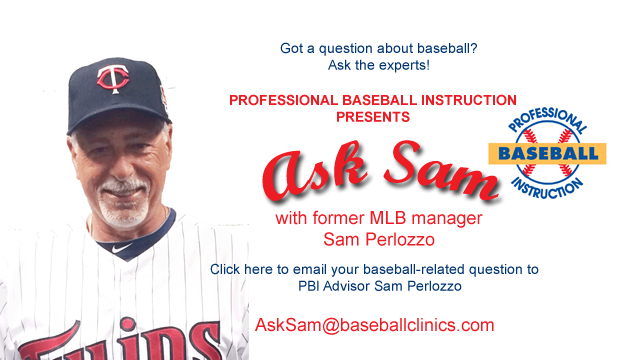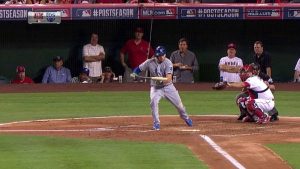
Welcome to the latest “Ask Sam.”
I’m Sam Perlozzo and I’m the minor league infield and baserunning coordinator for the Minnesota Twins. A former manager and coach at the major league level, I am also one of Professional Baseball Instruction’s Major League Advisors. Each month, I answer your baseball-related questions.
 Before we get into this month’s questions, I want to remind you about something that I’m involved in and very excited about. Fellow PBI Advisor Leo Mazzone and I have teamed up with former MLB players Roy Halladay, Dave Magadan, Jody Reed, Tom Foley and others on a new website called Inside Baseball. We offer the world’s largest online library of baseball training videos with proven advice and training methods designed to help baseball players of all abilities improve their game. I hope you’ll take a few moments to check out the website; there’s a lot of excellent information there.
Before we get into this month’s questions, I want to remind you about something that I’m involved in and very excited about. Fellow PBI Advisor Leo Mazzone and I have teamed up with former MLB players Roy Halladay, Dave Magadan, Jody Reed, Tom Foley and others on a new website called Inside Baseball. We offer the world’s largest online library of baseball training videos with proven advice and training methods designed to help baseball players of all abilities improve their game. I hope you’ll take a few moments to check out the website; there’s a lot of excellent information there.
Now, let’s get to your questions. And remember, if you have something you’d like to ask, email me directly – AskSam@baseballclinics.com.

Photo courtesy of MLB.com
A: Don, first of all, I need you to know I am not much of a gimmick guy. What I mean by that, is, I do most drills that emulate what happens in the game. So any fancy tricks I don’t do. I’ll give you a few things I do on the field, but we have really good strength and conditioning guys who do a tremendous job with all kinds of skill and movement drills and workouts. If I were you, I would look up those exercises and drills on line and pick out some that you like. And if you are really serious, I would find a professional person that can really give you a great program for the years in front of you now.
That said, my favorite drill for footwork and quickness is called a “drop ball” drill. You will need two more people other than yourself for the drill. I have a fungo guy stand various distances away from you and someone tosses the ball to the fungo man and he hits it at me. This give you a great chance to use your feet and move whichever way the ball is being hit. It also helps your timing of your start position. So the closer the fungo man is the quicker you’ll have to be. And he can vary how hard he hits the ball. So not only will this help your footwork for quickness, but also helps you read the bat and be ready to move that direction quicker.
Now if you really want to improve your range, you will need to know what pitch and what location the pitcher is intending to throw to the batter. Therefore, you must look in at the catcher and see ALL the signs he gives to the pitcher. By knowing the kind of pitch and the location of the pitch you will be more ready to get off the mark and increase your range because you will know better where you expect the batter to hit the ball. You will be amazed how that helps you get of the mark and get good jumps on all ground ball. So have some fun, do your drills, and please don’t forget about the signs. Best of luck, Sam

Photo courtesy of MLB.com
A: George, first thing I would do would be to use a ball. I can understand a walk-thru to get the proper location for everyone to be but until you use a ball and they can actually see what’s happening in front of them, I don’t know how they will learn. We, as professionals, run thru bunt defenses all the time and just roll the ball. At least they see the ball and we can vary how hard to roll it and where to roll it so they can learn to make adjustments.
Same goes for cut offs, relays etc. where everyone has a place to go. There are also web sites out there that actually walk you thru a series of bunt plays etc. so you can actually look at it from a screen. I am part of a web site that does that very thing (check out Inside Baseball). Even have a CD so they can take with them.
There really aren’t any short cuts to practice. We go over and over these plays all spring and even once or twice a month during the season. Try and relax, sooner or later they will eventually get it. Don’t give them too much at once. Maybe you pick one or two plays that day and work on them until they get them down instead of bombarding them with the whole gamut. I live with the KISS theory – “Keep It Simple, Stupid!!” Ha Ha Hang in there. Sam
Q: Sam, please tell me what you would have your players (or high school level girls) do in the following situation: top of the 4th (7 inning game), your team is in the field and your up 4-2 with 1 out and your opponent has runners on 2nd & 3rd…the batter hits a routine grounder to 2nd base (who cleanly fielded the ball in front of the base line). How would you coach the 2nd baseman? Throw the ball home to stop the runner from scoring or get the sure out at first and allow the run to score? Thanks! Dena
A: Dena, I read your question and the only thing I’m not sure of is how close your 2nd baseman is to home. I would normally play my infielders back with 2nd and 3rd and try to get the out. It’s still the middle of the game, therefore I am trying to stay away from the “big” inning. Having a two run lead tells me to move back so as not to let a ball get thru the infield if they were up in the baseline. That would be the normal call in most games.
Things can always change because you know your team better than anyone. You may not have any pitching available for the rest of the game and therefore have to stop the scoring at that point. Also, you may not feel like you can score any more runs so you can’t afford to give up any more runs again.
So I guess, my answer would be to play your infielders back and get the out at first and not let the ball get through to tie the score. I think that would be the most heard course of action you would hear from most baseball people. Good question.
Good luck, Sam
Thanks again for the great questions. I always enjoy talking baseball with people. Send your questions to me via email at AskSam@baseballclinics.com.






Speak Your Mind